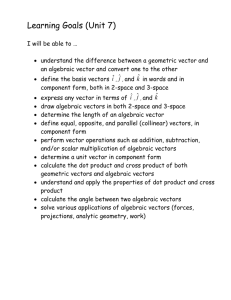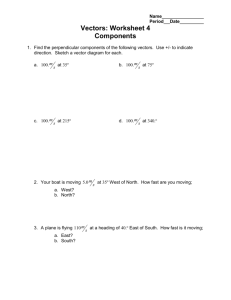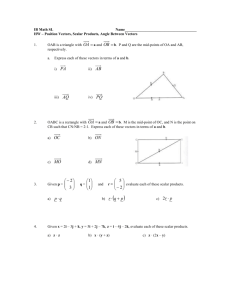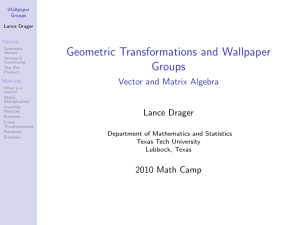EXAM 1 STUDY GUIDE
advertisement
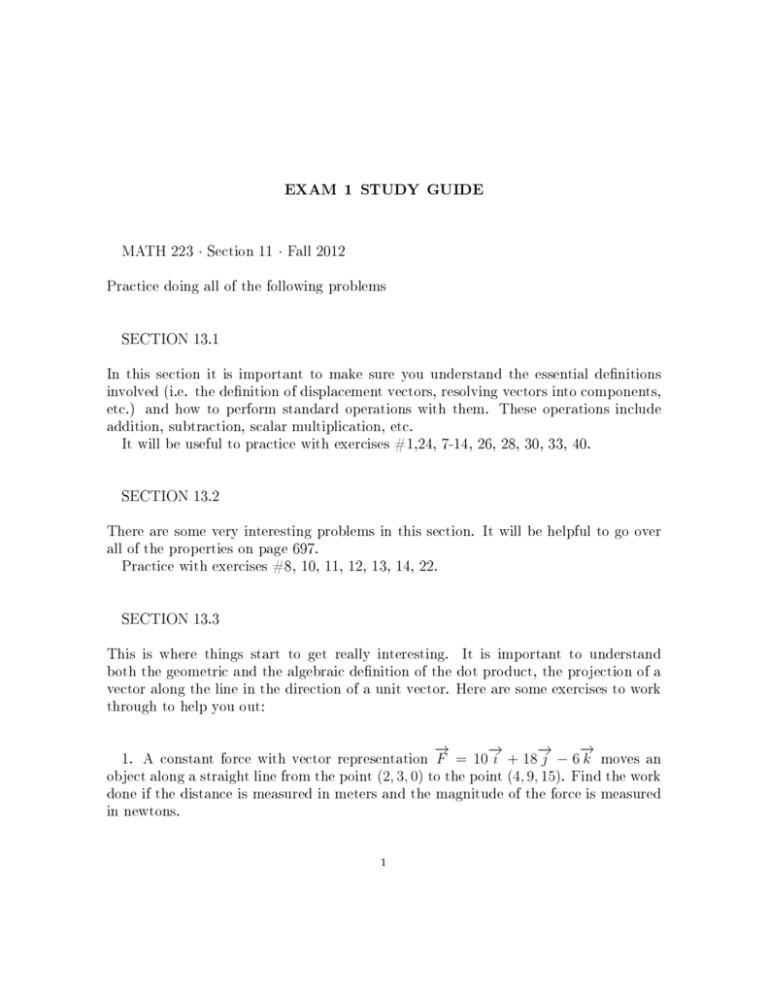
EXAM 1 STUDY GUIDE MATH 223 · Section 11 · Fall 2012 Practice doing all of the following problems SECTION 13.1 In this section it is important to make sure you understand the essential denitions involved (i.e. the denition of displacement vectors, resolving vectors into components, etc.) and how to perform standard operations with them. These operations include addition, subtraction, scalar multiplication, etc. It will be useful to practice with exercises #1,24, 7-14, 26, 28, 30, 33, 40. SECTION 13.2 There are some very interesting problems in this section. It will be helpful to go over all of the properties on page 697. Practice with exercises #8, 10, 11, 12, 13, 14, 22. SECTION 13.3 This is where things start to get really interesting. It is important to understand both the geometric and the algebraic denition of the dot product, the projection of a vector along the line in the direction of a unit vector. Here are some exercises to work through to help you out: → − → − → − → − 1. A constant force with vector representation F = 10 i + 18 j − 6 k moves an object along a straight line from the point (2, 3, 0) to the point (4, 9, 15). Find the work done if the distance is measured in meters and the magnitude of the force is measured in newtons. 1 2 EXAM 1 STUDY GUIDE 2. Find the work done by a force of 20 lb acting in the direction 50◦ north of west in moving an object 4 ft. due west. 3. A wagon is pulled a distance of 100 m along a horizontal path by a constant force of 50 N. The handle of the wagon is held at an angle of 30◦ above the horizontal. How much work is done? 4. Find the angle between the diagonal of a cube and one of its edges. − − − − − 5. Let → v and → u be vectors with ||→ u || = 1. Let → v parallel be the projection of → v → − → − → − → − along the line in the direction of u . Show that v perp = v − v parallel is perpendicular − to → u. 6. Two planes are parallel if the have normal vectors which are parallel (or pointing in opposite directions). Find the equation of the plane which is parallel to 3x+y +z = 4 and which passes through the point (−2, 3, 2). Practice the following problems in the book: # 28, 29, 30, 31, 33, SECTION 13.4 - This is the section on the cross product. As with the dot product, it is important to be able to understand (and do computations with) both the geometric and the algebraic denitions of the cross product. Read through the properties on page 712. Here are some exercises: → − → − → − → − → − 1. Find two unit vectors perpendicular to both i + j + k and 2 i + k . → − → − → − − − a × b · b = 0 for all vectors → a and b . 2. Show that → 3. Find an equation for the plane passing through the points P = (2, 1, 5), Q = (−1, 3, 4) and R = (3, 0, 6). EXAM 1 STUDY GUIDE 3 The following exercises in the book are helpful: # 1-7, 8, 9, 16, 17, 19, 24, 34, 36 SECTION 12.1 - Functions of two variables. Let's just get to the problems. The following problems from the book are helpful: # 1, 3, 5, 7, 9, 10-12, 19, 22, 24, 32 SECTION 12.2 - In this section it is important to understand how to use cross sections and tables to be able to visualize the graph of a function of two variables. Practice the following problems from the book: # 3-10, 19, 20, 21, 22 SECTION 12.3 - Contour diagrams are perhaps even more useful than cross sections for helping to visualize the graphs of functions of two variables. There are some pretty good exercises in the book: #5-13, 16, 17, 29, 30 SECTION 12.4 - Practice the following problems on linear functions. #1-10, 12, 21, 22, 29 SECTION 12.5 - Being able to conceptualize level surfaces will certainly come in handy later on in the course. Therefore, you should practice the following problems in the book: #1, 2, 6, 12, 14, 19, 22, 23, 24, 25, 27, 28




